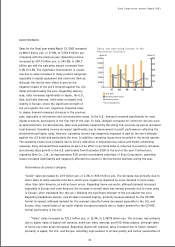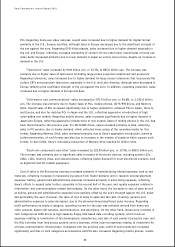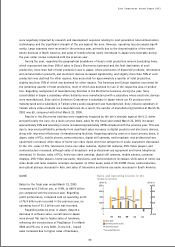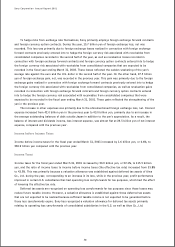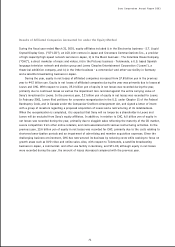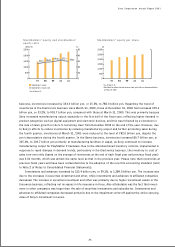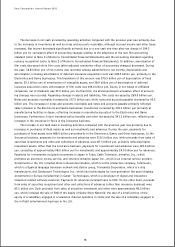Sony 2001 Annual Report Download - page 72
Download and view the complete annual report
Please find page 72 of the 2001 Sony annual report below. You can navigate through the pages in the report by either clicking on the pages listed below, or by using the keyword search tool below to find specific information within the annual report.
Sony Corporation Annual Report 2001
70
To hedge risks from exchange rate fluctuations, Sony primarily employs foreign exchange forward contracts
and foreign currency option contracts. During the year, 15.7 billion yen of foreign exchange loss, net was
recorded. This loss was primarily due to foreign exchange losses realized in connection with foreign exchange
forward contracts previously entered into to hedge the foreign currency risk associated with receivables from
consolidated companies recorded in the second half of the year, as well as revaluation losses recorded in
connection with foreign exchange forward contracts and foreign currency option contracts entered into to hedge
the foreign currency risk associated with receivables from consolidated companies that are expected to be
recorded in the fiscal year ending March 31, 2002. These losses reflected the sudden weakening of the yen’s
average rate against the euro and the U.S. dollar in the second half of the year. On the other hand, 27.5 billion
yen of foreign exchange gain, net, was recorded in the previous year. This gain was primarily due to the foreign
exchange gains realized in connection with foreign exchange forward contracts previously entered into to hedge
the foreign currency risk associated with receivables from consolidated companies, as well as revaluation gains
recorded in connection with foreign exchange forward contracts and foreign currency option contracts entered
into to hedge the foreign currency risk associated with receivables from consolidated companies that were
expected to be recorded in the fiscal year ending March 31, 2001. These gains reflected the strengthening of the
yen in the previous year.
The increase in other expenses was primarily due to the aforementioned foreign exchange loss, net. Interest
expense increased from 42.0 billion yen in the previous year to 43.0 billion yen, primarily due to an increase in
the average outstanding balances of debt outside Japan in addition to the yen’s appreciation. As a result, the
balance of interest and dividends income, less interest expense, was almost flat at 24.5 billion yen of net interest
expense, compared with the previous year.
Income before Income Taxes
Income before income taxes for the fiscal year ended March 31, 2001 increased by 1.6 billion yen, or 0.6%, to
265.9 billion yen compared with the previous year.
Income Taxes
Income taxes for the fiscal year ended March 31, 2001 increased by 20.9 billion yen, or 22.1%, to 115.5 billion
yen, and the ratio of income taxes to income before income taxes (the effective tax rate) increased from 35.8%
to 43.5%. This was primarily because a valuation allowance was established against deferred tax assets of Aiwa
Co., Ltd. during the year, corresponding to an increase in its loss, while in the previous year, profit performance
improved in certain U.S. subsidiaries that had operating loss carryforwards for tax purposes, which had the effect
of lowering the effective tax rate.
Deferred tax assets are recognized on operating loss carryforwards for tax purposes since these losses may
reduce future taxable income. However, a valuation allowance is established against those deferred tax assets
that are not expected to be realized because sufficient taxable income is not expected to be generated before
those loss carryforwards expire. Sony has recognized a valuation allowance for deferred tax assets primarily
relating to operating loss carryforwards of consolidated subsidiaries in the U.S. as well as Aiwa Co., Ltd.



